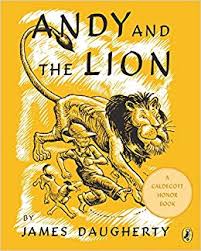James Daugherty
Listen to the Recess! Clip
| Author | Rita Smith |
| Air Date | 6/7/2004 |

James Daugherty Transcript
James Daugherty was already an accomplished artist when he brought his talents to children’s literature. He had studied Baroque art in Europe, painted camouflage on ships in cubist shapes for the Navy during World War I, designed posters and painted murals in post offices, high schools and movie theaters. His experience with the ships and murals led him to an expansive style with large figures and sweeping forms which was simplified and transformed in his book illustrations into lively almost animated drawings filled with humor and gusto.
His first picture book, Andy and the Lion, is a wonderful example of this. The book tells a modern day version of the Androcles and the Lion fable. Andy, a young boy, loves lions and gets a book from the library about lions. The next day on the way to school he encounters a lion, who shows Andy the thorn in his paw which Andy extracts. The lion expresses his gratitude and they part company. Months later, the circus comes to town and one of the lions escapes terrorizing the audience. It is the lion Andy helped and they recognize each other. The lion does not hurt anyone and Andy prevents anyone from hurting or capturing the lion. The next day the town has a parade down main street and Andy receives a medal for bravery. The lion looks on proudly and later goes with Andy as he returns the lion book to the library. It is a whimsical combination of fact and fancy.
The pictures, full of lively detail and brimming with life and energy, could carry the tale alone and in fact that is the way Daugherty originally designed it. He took the 36 drawings for the book into an editor who loved them and agreed to make them into a book. The book went into production with no text at all. In 1937 the wordless picture book was not the accepted format it is today and it bothered some of the editorial staff who felt that people were not used to reading pictures without text.
They asked Daugherty to write a story to go with the pictures, but, since he had never written anything in his life except for some personal letters, he declined. One of the editors had a go at writing the story, but Daugherty didn’t like it. He thought the words were superfluous. Finally, the editor called him into her office. “What are we going to do?” she asked. “Here are your splendid pictures, but no story to go with them. And the rest of the staff feel that we must have a story.” They were at an impasse. Finally she held up the first picture and asked Daughtery what he could say about it. “Well,” he responded, “how about …’It was a bright day with just enough wind to float a flag. Andy started down to the library’…” The editor wrote this down and held up the second one, “Okay,” she said, “How about this one?” And in this fashion they worked through all 36 pictures. In a half hour they had their text and the book was complete.
Daughtery went on to produce many other books for children and in spite of his original reluctance to write a story, he developed an exuberant prose style which complimented perfectly his illustrations and both were present in all his following work.
Sources:
Bader, Barbara, American Picturebooks from Noah’s Ark to the Beast Within. New York: Macmillan Publishing Co., 1976, p. 151-154.
Montgomery, Elizabeth Rider, The Story Behind Modern Books, New York: Dodd, Mead & Company, 1949. p, 23-29.